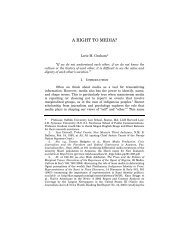The Right to Dignity Rex D. Glensy - Columbia Law School
The Right to Dignity Rex D. Glensy - Columbia Law School
The Right to Dignity Rex D. Glensy - Columbia Law School
Create successful ePaper yourself
Turn your PDF publications into a flip-book with our unique Google optimized e-Paper software.
2011] <strong>The</strong> <strong>Right</strong> <strong>to</strong> <strong>Dignity</strong> 141<br />
IV. CONCLUSION<br />
All four approaches presented in Part III above contain<br />
attractive characteristics, and all four have certain shortfalls that can<br />
be addressed (as done above), albeit imperfectly. <strong>The</strong> key <strong>to</strong> the<br />
answer should be the ease in which each proposed approach could be<br />
integrated within already existing American jurisprudence. This<br />
guideline is premised not only on the goal of giving the right <strong>to</strong><br />
dignity its maximum realistic effect upon U.S. law, but also on the<br />
practical reality that law rarely proceeds with major jolts, but rather<br />
is more adept <strong>to</strong> cautious incremental change. While a detailed<br />
research agenda—the scope of which exceeds that of this Article—<br />
should be structured <strong>to</strong> answer the question posed, preliminarily, my<br />
choice would rest on the proxy approach.<br />
<strong>The</strong> positive rights approach, while probably the most robust<br />
and effective use of the right <strong>to</strong> dignity, is relatively uncommon in the<br />
United States. Its implementation would necessitate the most radical<br />
rethinking not only of dignity rights, but also of constitutional rights<br />
and causes of action in general. <strong>The</strong> negative rights approach is<br />
rather tempting, if one believes in the propriety of protecting<br />
dignitary interests; however, the ubiquity of dignity would render its<br />
impact almost meaningless. 340 <strong>The</strong> expressive approach, in many<br />
ways, is subsumed within each of the other three approaches, because<br />
one cannot detach the horta<strong>to</strong>ry value from the use of the term<br />
without actually using the term, so it will always play a role<br />
regardless of which approach is chosen. Nevertheless, the weakness<br />
with having an approach that is solely expressive is just that—in a<br />
strictly legal sense it has little impact, and in the nonlegal sense it<br />
would be difficult <strong>to</strong> predict what its influence eventually would be.<br />
<strong>The</strong> proxy approach is that with which the use of dignity best<br />
fits within presently framed constitutional, statu<strong>to</strong>ry, and common<br />
law standards. It requires the least amount of adjustment with<br />
current doctrine and gives the right <strong>to</strong> dignity its appropriate role<br />
within the constellation of rights that are already protected in the<br />
United States. One might question choosing one approach at all, and<br />
340. This is the main problem with the thesis presented by Maxine<br />
Goodman. She lists a litany of doctrines that would be affected by having dignity<br />
as an underlying norm, and by the end of that list, one is left wondering if there is<br />
anything left. See Goodman, supra note 23, at 753 (“[H]uman dignity . . . underlies<br />
our constitutional rights <strong>to</strong> privacy, liberty, protection against unreasonable<br />
search and seizure, protection against cruel and unusual punishment, and other<br />
express rights and guarantees.”).















